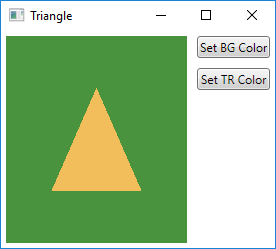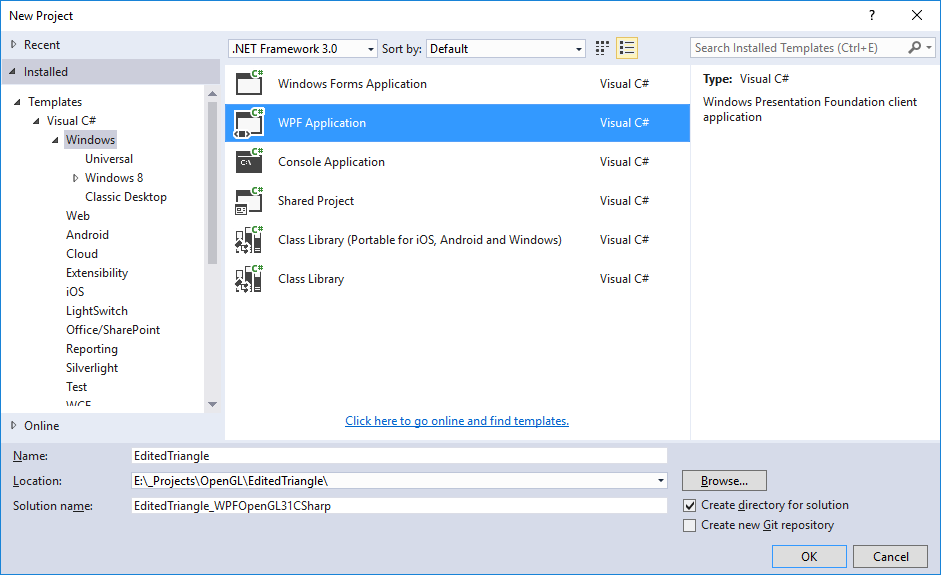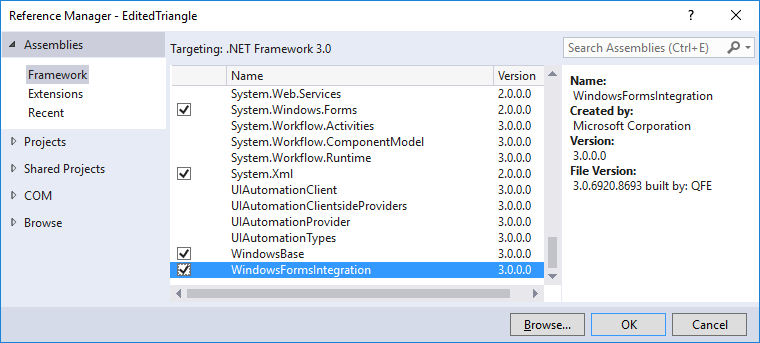We will see how to place OpenTK.GLControl on WPF window to make GUI application with 2D/3D graphics using modern OpenGL 3.

How to create the project from scratch
Note 1: RMB - Right Mouse Button click
Note 2: Good Color calculator for normalized values: http://doc.instantreality.org/tools/color_calculator/
- Create WPF application, with the name "EditedTriangle". See the screenshot:
Spoiler

- Download OpenTK.GLControl.zip and OpenTK.zip
- Create the empty "Libs" folder in the solution folder (where the ".sln" is placed)
- Unzip "OpenTK" and "OpenTK.GLControl" folder in the "Libs" folder
- Add references to "OpenTK.dll" and "OpenTK.GLControl.dll". For this: RMB on "References" -> select "Add Reference..." -> select "Browse" -> click the "Browse..." button -> select DLL's. See the screenshot with the result:
Spoiler

- Add "Assemblies". For this: select "Assemblies" -> "Framework" -> check:
System.Drawing System.Windows.Forms WindowsFormsIntegration
, see the screenshot with the result:
Spoiler

- Click "OK" button
- Open the "MainWindow.xaml" and "MainWindow.xaml.cs” files in VS and edit code like this:
<Window x:Class="EditedTriangle.MainWindow"
xmlns="http://schemas.microsoft.com/winfx/2006/xaml/presentation"
xmlns:x="http://schemas.microsoft.com/winfx/2006/xaml"
xmlns:d="http://schemas.microsoft.com/expression/blend/2008"
xmlns:mc="http://schemas.openxmlformats.org/markup-compatibility/2006"
xmlns:local="clr-namespace:EditedTriangle"
xmlns:opentk="clr-namespace:OpenTK;assembly=OpenTK.GLControl"
mc:Ignorable="d"
Title="Triangle" Height="256" Width="290">
<Grid>
<DockPanel LastChildFill="True">
<StackPanel DockPanel.Dock="Right">
<Button x:Name="buttonSetBGColor" Content="Set BG Color" Margin="5" Click="buttonSetBGColor_Click"></Button>
<Button x:Name="buttonSetTRColor" Content="Set TR Color" Margin="5" Click="buttonSetTRColor_Click"></Button>
</StackPanel>
<WindowsFormsHost Margin="5">
<opentk:GLControl x:Name="glControl" Load="glControl_Load" Paint="glControl_Paint" />
</WindowsFormsHost>
</DockPanel>
</Grid>
</Window>
using System;
using System.Windows;
using OpenTK.Graphics.OpenGL;
using OpenTK.Graphics;
namespace EditedTriangle
{
/// <summary>
/// Interaction logic for MainWindow.xaml
/// </summary>
public partial class MainWindow : Window
{
private int _numOfVertices = 0;
private int _uColorLocation;
public MainWindow()
{
InitializeComponent();
}
private void glControl_Load(object sender, EventArgs e)
{
glControl.MakeCurrent();
// Get a shader program ID
int shaderProgram = InitShadersAndGetProgram();
_numOfVertices = InitVertexBuffers();
_uColorLocation = GL.GetUniformLocation(shaderProgram, "uColor");
if (_uColorLocation < 0)
{
MessageBox.Show("Failed to get uColorLocation variable");
return;
}
// Set a triangle color
GL.Uniform3(_uColorLocation, 0.945f, 0.745f, 0.356f);
// Set a color for clearing the glCotrol
GL.ClearColor(new Color4(0.286f, 0.576f, 0.243f, 1f));
}
private void glControl_Paint(object sender, System.Windows.Forms.PaintEventArgs e)
{
GL.Viewport(0, 0, glControl.Width, glControl.Height);
// Clear the glControl with set color
GL.Clear(ClearBufferMask.ColorBufferBit);
if (_numOfVertices != 0)
{
GL.DrawArrays(PrimitiveType.Triangles, 0, _numOfVertices);
}
// Swap the front and back buffers
glControl.SwapBuffers();
}
private int InitVertexBuffers()
{
float[] vertices = new float[]
{
0.0f, 0.5f,
-0.5f, -0.5f,
0.5f, -0.5f
};
int n = 3;
int vbo;
GL.GenBuffers(1, out vbo);
// Get an array size in bytes
GL.BindBuffer(BufferTarget.ArrayBuffer, vbo);
int sizeInBytes = vertices.Length * sizeof(float);
// Send the vertex array to a video card memory
GL.BufferData(BufferTarget.ArrayBuffer, sizeInBytes, vertices, BufferUsageHint.StaticDraw);
// Config the aPosition variable
GL.VertexAttribPointer(0, 2, VertexAttribPointerType.Float, false, 0, 0);
GL.EnableVertexAttribArray(0);
return n;
}
private int InitShadersAndGetProgram()
{
string vertexShaderSource =
"#version 140\n" +
"in vec2 aPosition;" +
"void main()" +
"{" +
" gl_Position = vec4(aPosition, 1.0, 1.0);" +
"}";
string fragmentShaderSource =
"#version 140\n" +
"out vec4 fragColor;" +
"uniform vec3 uColor;" +
"void main()" +
"{" +
" fragColor = vec4(uColor, 1.0);" +
"}";
// Vertex Shader
int vShader = GL.CreateShader(ShaderType.VertexShader);
GL.ShaderSource(vShader, vertexShaderSource);
GL.CompileShader(vShader);
// Check compilation
int ok;
GL.GetShader(vShader, ShaderParameter.CompileStatus, out ok);
if (ok == 0)
{
string vShaderInfo = GL.GetShaderInfoLog(vShader);
MessageBox.Show("Error in the vertex shader:\n" + vShaderInfo);
return -1;
}
// Fragment Shader
int fShader = GL.CreateShader(ShaderType.FragmentShader);
GL.ShaderSource(fShader, fragmentShaderSource);
GL.CompileShader(fShader);
GL.GetShader(fShader, ShaderParameter.CompileStatus, out ok);
if (ok == 0)
{
string fShaderInfo = GL.GetShaderInfoLog(fShader);
MessageBox.Show("Error in the fragment shader:\n" + fShaderInfo);
return -1;
}
int program = GL.CreateProgram();
GL.AttachShader(program, vShader);
GL.AttachShader(program, fShader);
GL.LinkProgram(program);
GL.UseProgram(program);
return program;
}
private void buttonSetBGColor_Click(object sender, RoutedEventArgs e)
{
var dialog = new System.Windows.Forms.ColorDialog();
if (dialog.ShowDialog() == System.Windows.Forms.DialogResult.OK)
{
GL.ClearColor(dialog.Color);
glControl.Invalidate();
}
}
private void buttonSetTRColor_Click(object sender, RoutedEventArgs e)
{
var dialog = new System.Windows.Forms.ColorDialog();
if (dialog.ShowDialog() == System.Windows.Forms.DialogResult.OK)
{
float r = dialog.Color.R / 255f;
float g = dialog.Color.G / 255f;
float b = dialog.Color.B / 255f;
GL.Uniform3(_uColorLocation, r, g, b);
glControl.Invalidate();
}
}
}
}




Looks good except missing Utils class?